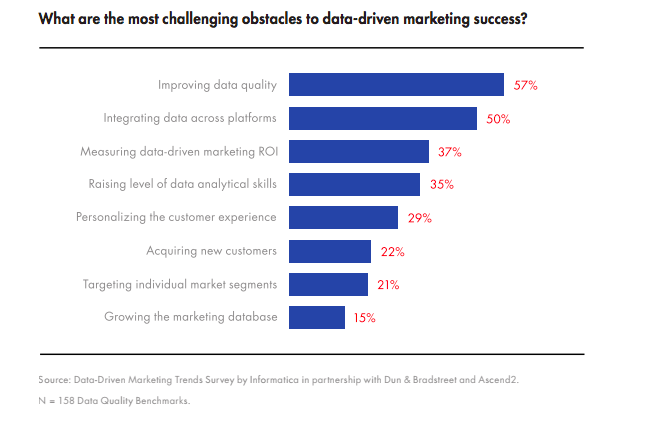Big Data Analytics for Marketers: 4 Steps to Use It Effectively
With a predicted 2.77 billion social media users worldwide by 2019, social media has become a key source of consumer insights for brands. In addition to helping companies understand their online reputation and customers better, it can also help identify and develop new business opportunities.
But while big data is readily available online, marketers need to filter it down to make it meaningful enough to act upon and inspire data-driven initiatives. In fact, a 2016 study by Informatica, D&B, and Ascend2, found that lack of data quality and integration was a major obstacle to implementing insight-driven strategies.

Only by focusing on relevant, filtered data sets, can brands quickly and effectively fine-tune their strategies and make informed decisions to address business challenges.
Much has been said about why smart data is important for businesses, and how marketers can interpret filtered metrics for their campaigns. To truly add business value when using smart data, marketers must:
- Define campaign objectives,
- Leverage customised dashboards,
- Add your own insights, and
- Share valuable data with other departments
1. Define Campaign Objectives
At the outset of any marketing campaign, lies the overall strategy and goals.
Campaign objectives are crucial for selecting the corresponding KPIs and supporting metrics that will determine your ROI measurement and eventually, success. Once you have identified your objective, consider each information channel’s relevance to your end goal, and identify the appropriate data sets to detect the right metrics.
For larger scale campaigns, segment and deliver the data that supports each department, partner or vendor’s specific role in your project, so they can fine-tune their activities accordingly to boost overall performance.
2. Leverage Customised Dashboards
In addition to deploying software to gather and aggregate data in real time, using customised dashboards is helpful for visualising and distributing relevant insights to project collaborators.
 Example of a customised dashboard displaying social media data related to brand satisfaction. Brand names have been omitted.
Example of a customised dashboard displaying social media data related to brand satisfaction. Brand names have been omitted.
Visualising data in digestible formats can go a long way in helping teams to:
- Understand key concepts around their brands and industry,
- Visualise the association of their brand with other brands or verticals,
- Examine how different markets integrate and connect with each other,
- Discover emerging trends, and
- Better understand and act on real-time insights from thousands of customer conversations
3. Add Your Own Insights
Contextualise insights gathered by considering:
- Time frame studied,
- Company activities including campaigns, launches, and other incidents,
- Social, political or economic activities, and
- Competitor activity
Just like how a marketing campaign needs to drive a desired action to succeed, so too should your data analysis with the intended recipient. Use storytelling to make it easy for teams to interpret smart data - and act on it!
At the same time, avoid overloading project collaborators with too much information. Ensure everyone is on the same page, by tracking discussions on shared Google documents and spreadsheets, project management dashboards and dedicated chat groups.
 Example of a company’s Slack channel, with various chat channels dedicated to specific projects and teams.
Example of a company’s Slack channel, with various chat channels dedicated to specific projects and teams.4. Share Valuable Data with Other Departments
Gone are the days of operating in silos. Companies must activate all data points available to them and strengthen day-to-day operations and strategies beyond marketing functions.
Sustained communication across departments, is key to delivering valuable data to the right team. To do this:
- Collate and distribute the latest findings via personalised, internal newsletters,
- Employ evangelists to champion regular meetings across departments, or
- Invest in a physical command center to display data gathered in real time
Bonus: See how ASUS developed and launched their ZenFone Zoom S, based on insights delivered to their R&D and marketing teams from customer conversations around smartphone features.
What’s Next?
If used well, smart data creates value at all levels of the organisation, from developing insights about what drives your business and customers, allowing you to outpace your competitors in the long run. As data aggregation technologies continue to evolve, brands must be more prepared than ever to interpret and use smart data for their strategies and day to day operations.
Discover the 8 unique business opportunities you can identify and develop on social media in our free eBook!
Written by Melissa Chue
Melissa is a digital advocate who loves diving into the latest trends in digital and social media. Since joining Digimind’s marketing team in 2015, she has written studies for over 15 industries in Asia Pacific. When she is not telling stories about data, Melissa can be found exploring her favourite cafes and hangouts on Instagram @chuepachups.

